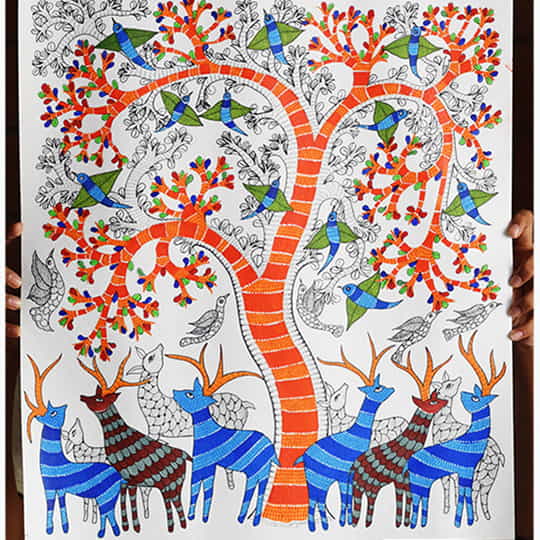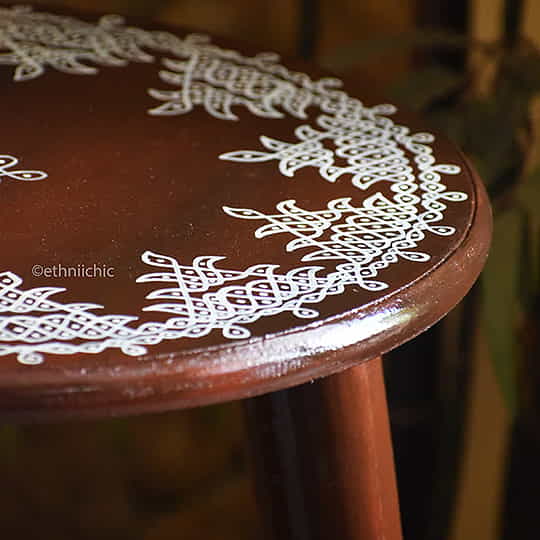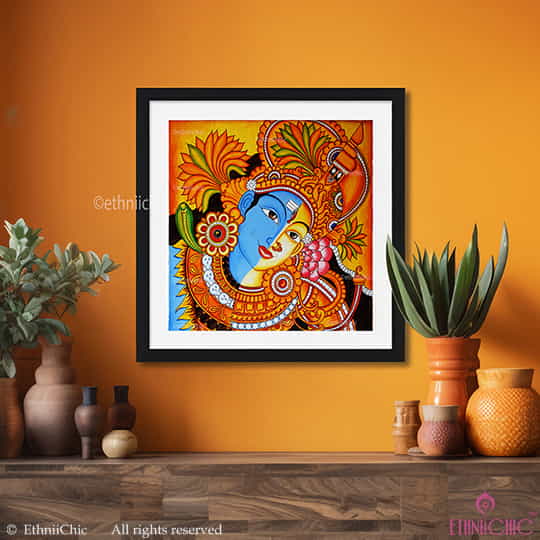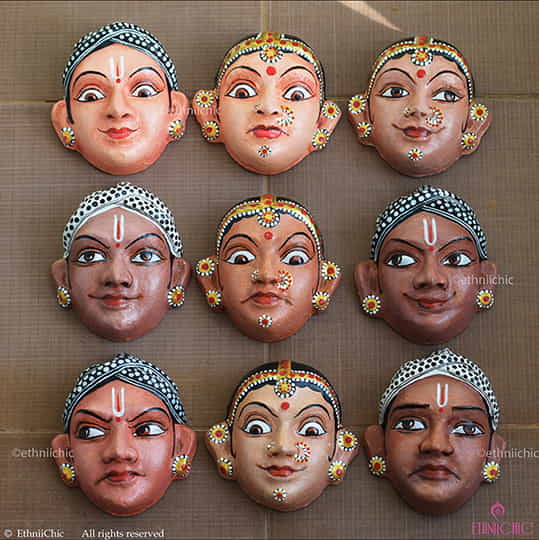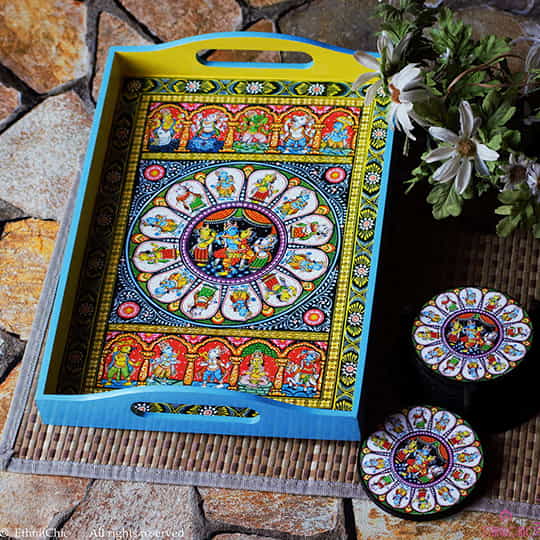On a bright, sun-drenched afternoon, in the heart of Madhya Pradesh, two friends—Aarti and Rohan—embarked on a journey that would take them deep into the world of indigenous art. Aarti, a passionate art historian, had long admired the rich tapestry of Indian folk traditions. Rohan, a budding painter, sought inspiration from the roots of artistic expression. Their destination? The quaint villages where the legendary Gond and Bhil art forms were born.
At first glance, to an untrained eye, Gond and Bhil art might appear strikingly similar. Both are vibrant, both draw heavily from nature and tribal folklore, and both use intricate detailing that transforms simple depictions into mesmerizing compositions. Whether it’s a tree brimming with life or a scene from tribal festivities, the explosion of color and texture in both art forms makes them seem like reflections of the same tradition. However, as Aarti and Rohan would soon discover, the deeper they delved, the more distinct these two forms revealed themselves to be.
A Journey Into Tradition
Their first stop was Patangarh, a village synonymous with Gond art. As they walked through the narrow lanes, their eyes fell on the walls adorned with intricate patterns—trees with veins flowing like rivers, animals detailed with elaborate textures, and mythological tales frozen in vibrant hues. They met an elderly artist named Dhaniram, who welcomed them into his humble home.
Dhaniram, seated on a woven mat, held a fine-tipped brush in his hand. “Gond art is storytelling in its purest form,” he explained. “We believe that everything in nature has a spirit, and we honor these spirits by giving them life through our brushstrokes.”
Aarti leaned in, mesmerized by the fluidity of the patterns. “I notice a lot of fine dots and lines. Is that a signature of Gond art?” she asked.
Dhaniram nodded. “Yes, we use delicate lines, dots, and intricate patterns to create movement and depth. This technique is inspired by our oral traditions, where stories flow seamlessly from one generation to the next. Each artist brings their own rhythm, making every piece unique.”
Rohan studied a painting of a peacock intertwined with a tree, its feathers forming a mesmerizing wave of patterns. “The colors are striking too! Are they natural?”
“Traditionally, yes,” Dhaniram said with pride. “We extract colors from charcoal, cow dung, leaves, flowers, and soil. But today, many artists also use acrylic paints to keep up with modern times.”
After thanking Dhaniram, the duo ventured onward, eager to compare this with Bhil art.
The Dotted World of Bhil Art
Their next stop was Jhabua, the heartland of Bhil art. Here, another seasoned artist, Kamla Bai, sat outside her home, painting a canvas covered in tiny, rhythmic dots. She smiled warmly as they approached. “Welcome, travelers! Have you come to see our stories dance on canvas?”
Rohan was immediately drawn to the artwork. Unlike the intricate textures of Gond paintings, Bhil art had a more uniform pattern—dots, thousands of them, meticulously arranged to create a sense of movement.
“Why dots?” Aarti asked, her curiosity piqued.
Kamla Bai chuckled. “For us, dots are everything. They represent grains, seeds, the essence of life itself. Our ancestors painted on walls and floors using neem twigs dipped in natural colors. The dots not only fill the space but also connect the past with the present, much like how our stories are passed down.”
Aarti ran her fingers gently over a dried painting. “It’s like a rhythmic pattern, almost meditative.”
“Exactly,” Kamla Bai said. “Each dot is placed with intention. Unlike Gond art, where patterns create movement, we use dots to bring harmony and texture.”
Rohan noticed the themes depicted in Bhil paintings—deer grazing under a mango tree, a tribal woman balancing pots on her head, and a festival scene with people dancing in circles. “The themes seem very rooted in daily life and nature.”
Kamla Bai nodded. “Bhil art is deeply connected to our way of life. Our paintings celebrate harvests, seasons, festivals, and spirits that protect us. We do not use elaborate storytelling like the Gonds; instead, we let the dots form a visual symphony of our world.”
Comparing the Two Art Forms
As the sun began to set, Aarti and Rohan sat by a small bonfire, reflecting on the differences between the two art forms.
“So, what do we have?” Aarti mused. “Gond art thrives on intricate linework and fluid storytelling, while Bhil art is more about dots that create a rhythmic, almost hypnotic effect.”
“Right!” Rohan added. “And while both are deeply rooted in nature, the Gond artists bring a mythical dimension, where animals, trees, and spirits are animated in a dreamlike manner. Bhil artists, on the other hand, celebrate daily life, traditions, and the earth’s bounty with their characteristic dots.”
“Even the technique differs,” Aarti noted. “Gond paintings use detailed patterns that follow the natural flow of the subject, while Bhil paintings use a meticulous dotting technique, creating a more uniform texture.”
Rohan grinned. “And the colors! Gond art originally used earth tones, though modern artists experiment with bright acrylics. Bhil art, on the other hand, sticks to a rich palette of reds, yellows, blues, and whites—all derived from nature.”
Aarti sighed contentedly. “Isn’t it fascinating how two tribal communities, living not far from each other, developed such distinct artistic styles? And yet, both art forms carry the soul of their people, their history, and their connection to the land.”
Rohan nodded. “It’s a reminder that art is not just about technique—it’s about legacy, culture, and the stories we choose to tell.”
The Takeaway
As they bid farewell to the village, Aarti and Rohan knew their journey had left an indelible mark on them. The difference between Gond and Bhil art was not just in technique or theme, but in the philosophy that shaped them. While Gond art danced between mythology and movement, Bhil art resonated with the pulse of everyday life, one dot at a time.
Their canvases may be different, but their spirit was the same—a celebration of life, memory, and tradition, immortalized in paint.
And as the two friends walked back into the city, they carried with them not just a deeper appreciation for folk art but also a renewed respect for the artists who keep these traditions alive, one brushstroke, one dot, and one story at a time.


